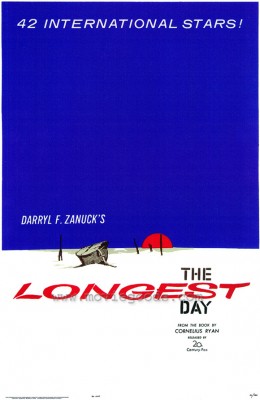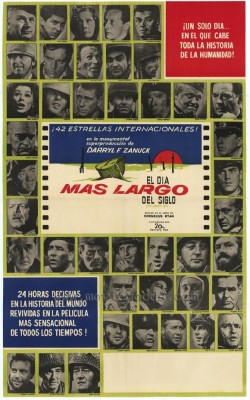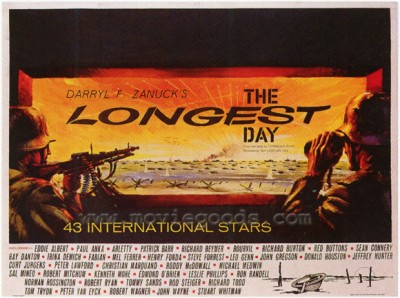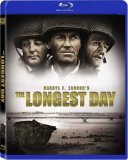| Reviews & Columns |
|
Reviews DVD TV on DVD Blu-ray 4K UHD International DVDs In Theaters Reviews by Studio Video Games Features Collector Series DVDs Easter Egg Database Interviews DVD Talk Radio Feature Articles Columns Anime Talk DVD Savant Horror DVDs The M.O.D. Squad Art House HD Talk Silent DVD
|
DVD Talk Forum |
|
|
| Resources |
|
DVD Price Search Customer Service #'s RCE Info Links |
|
Columns
|
|
|
Longest Day, The
Fox's Blu-ray presentation is outstanding. Starkly photographed in black and white, the disc offers some of the silkiest blacks this reviewer has ever seen - like India ink - and an unprecedented level of sharpness, much superior to the 35mm print this reviewer caught about a dozen years ago. On big screen TVs The Longest Day is sensational.
As its title suggests, the film is confined to a 24-hour period, from about early evening the night before "D-Day," when bad weather threatened to delay the massive operation once again, to late in the afternoon the following day, when the Beaches of Normandy had at last been secured, and British and American troops were racing inland, liberating German-occupied French villages.
The story of the invasion is told in short, sometimes inter-connecting episodes featuring four-star generals and ordinary foot soldiers, in little details exemplifying the logistical frustrations and tragic ironies of the battle, sometimes with wholly fictional characters but mostly with real-life ones, or at least composites of real soldiers. (Actor Richard Todd plays his own commanding officer from the real D-Day. At first it was suggested that he play himself but the actor demurred, joking that "the part was too small.") Though it boasts "42 International Stars," The Longest Day has no single central character. *
This was a radical departure for a Hollywood movie, as was the decision to shoot the film with the German characters speaking German and the French ones speaking French. Though an alternate version was reportedly shot simultaneously with the entire cast speaking English, the native languages version was the one released to most parts of the world. It was, unquestionably, the first time mainstream America experienced such a subtitle-heavy film.
Moreover, producer Darryl F. Zanuck assigned different directors to tackle each "language": Ken Annakin is credited with the "British Exterior Episodes," Andrew Marton with the "American Exterior Episodes," and Bernard Wicki with the "German Episodes." These credits are, however, murkily defined to say the least. Annakin also directed most or all of the French Resistance material featuring Irina Demick, Zanuck's girlfriend at the time, and some of the battle for Ouistreham. Zanuck himself "directed" some interiors, though Annakin jokes this was just for show; he'd set up all the shots, and Zanuck hung around only long enough to say "Action!" and "Cut!"
Meanwhile Gerd Oswald, who for reasons unknown isn't credited anywhere in the film at all, directed the entire disastrous parachute drop in Sainte-Mère-Église, arguably the best sequence in the entire picture. When they overshoot their drop zone, paratroopers including real-life hero John Steele (Red Buttons) end up landing in the city square, just as German troops and local citizens are battling a fire started by a wayward flare. Falling into plain sight from the darkness above, the helpless paratroopers can do nothing as the surprised Germans begin shooting madly, massacring the paratroopers, some of whom land squarely into the blazing inferno. Steele, his chute tangled up in the spires of a church steeple, watches aghast while dangling from above with his God-like (if horrified) perspective.
After Steven Spielberg's Saving Private Ryan, which literally covered much the same ground, some critics argued that film's graphic realism all but negated every World War II movie that had come before it, that Spielberg's movie was the first to "tell it like it was." Though you won't see soldiers eviscerated by landmines or sliced in two by machine gun fire - and in that sense earlier, bloodless war movies were dishonest by exclusion (not that such graphicness would have been allowed even if the filmmakers had wanted to include it) - scenes like the Sainte-Mère-Église tragedy more than adequately convey the horror and irony of war. Indeed throughout the film are similar moments, though none quite as powerful.
Despite all the directors, the film never plays like a jumble of styles, and the cutting - undoubtedly supervised by Associate Producer and ace cutter Elmo Williams, reportedly still with us at 95 - does a fantastic job slowly building tension as D-Day draws near: the first shot isn't fired until about 50 minutes into the film, and the beaches aren't reached until the 1:50 mark. The film also does a neat job "connecting the dots" bringing back characters late in the film as they hook up with others.
The picture is something of a transitional work. John Wayne seems to think he's still in a '40s-style, Sands of Iwo Jima-type gung-ho melodrama, though his reaction upon seeing the dead paratroopers dangling from trees and buildings in Sainte-Mère-Église's town square is priceless. Some actor cameos are awkward; Roddy McDowall is miscast as an Earl Hamner-type country boy for instance, while others like Richard Burton, as a hardened veteran of the Battle of Britain, are superb in their brief vignettes. Some of the older, more established stars, notably Wayne and Robert Mitchum, are on-hand to deliver necessary exposition and offer audiences some much-needed historical perspective and awe-inspiring statistics about the battle. A few, like Rod Steiger, turn up long enough to say a few lines then vanish, while others appear in two or three spaced-out scenes cleverly positioned to make their roles appear bigger than they are.
The roughly $10 million production is spectacular. The picture chokes with "money shots," most 1:1 full scale and, of course, nothing beefed up with CGI. There's a long, long helicopter shot flying over Ouistreham that's mind-boggling; the camera follows French Resistance fighters storming block after block with explosions all around. It looks like Zanuck and Co. took over the entire town just for that one shot. Something similar turns up at Gold-Juno Beach, in an aerial shot looking down on thousands of soldiers; it seems to go on forever.
The integration of real locations, many historical spots where the battles were actually fought, with studio interiors (some, like the scene with the sabotaged telephone lines, achieved with forced-perspective sets) are near-flawless, as is the mixing of day-for-night and night-for-night shooting.
There are a few miniatures and whatnot, but most of the special effects consist of optical composites. I'm no expert, but they look like sodium vapor shots that would have been filmed in color, which would account for the sudden jump in graininess. Though impressive then today they seem unreal, looking rather like blue screen/CGI composites commonplace today.
Video & Audio
The Longest Day is credited as a CinemaScope production, though I highly doubt Fox's official but inferior Bausch & Lomb lenses were utilized; the 1080p image is just too uniformly clean, undistorted, and with better depth-of-field. On Blu-ray one can see all manner of detail previous standard DVD editions just can't pick up. Just as high-definition television is great for things like sporting events where you can make out every face in the stadium, it's a godsend for war movies and a heck of a lot easier making out faces running around the battlefield. Possibly one reason the film looks as good as it does (and superior to earlier TV and home video incarnations) is that Fox appears to have gone back to the original camera negative while digitally supering all the subtitles (in an approximation of the original 1962 font), rather than go with lesser elements where the original subtitling has already been optically inserted.
Despite clocking in at 178 minutes, there's no overture, intermission, or exit music, though the film opens with several seconds of music before the first fade-in.
The film supposedly was originally released in both four- and six-track magnetic stereo, the latter for 70mm blow-up engagements. I don't recall there ever being much to the audio, quite unlike later 70mm roadshow war films. Fox offers mixes in both DTS HD 5.1 Master Lossless Audio and 4.0 Dolby Surround and while they're okay, neither offers much in the way of directional sound effects (though much is directed to the surround channels), all or almost all the dialogue is centered, and the music is by design sparse. French and Spanish-dubbed mono tracks are offered, along with subtitles in English and, peculiarly, Mandarin and Cantonese.
Extra Features
All of the supplements appear to be carry-overs from earlier standard DVD editions, most from Fox's "Cinema Classics Collection" and included on a separate standard DVD. Accompanying the film are previously released audio commentary tracks, one with co-director Ken Annakin the other with historian Mary Corey. Both are recommended.
An AMC Backstory from 2000 (4:3 standard size) gives a decent overview of the production with Zanuck at its center. A Day to Remember is a 17-minute, 16:9 featurette covering the same territory from Ken Annakin's point of view, while Darryl's studio head/producer son Richard offers yet another perspective on the film.
By far the most interesting extra is the sometimes bizarre and outright hilarious D-Day Revisited, apparently a 1968-69 television special commemorating the 25th anniversary of the Invasion of Normandy, improbably hosted by Darryl Zanuck himself. Wearing oversized sunglasses and speaking with a Wally Cox-like nasally tone, it's a then-and-now show with great color shots of the many historical locations also used in the film. In one especially peculiar scene, Dirty Old Man Zanuck picks up a 22-year-old French waitress and gives her a personal tour of one of the locations. She had to have been another one of his girlfriends.
A still gallery and 16:9 enhanced trailer for the general release version ("at popular prices") are also included.
Parting Thoughts
The release to Blu-ray of The Longest Day and other Fox and United Artists war movies shot in various formats (Patton, A Bridge Too Far, etc.) may have an impact beyond the movies themselves. They demonstrate once and for all that older library titles can have the same knock-yer-socks-off impact that recent CGI-heavy blockbusters do - even a film shot in black and white 'scope like The Longest Day. Quite simply it's one of the best-looking Blu-ray titles so far, one that lends itself to projection on 150-inch screens. A DVD Talk Collector Series Title.
* I once took a university course in screenplay writing and was told by the instructor in no uncertain terms that a good film cannot be made without a central, single protagonist. "Well," I asked, "What about Advise & Consent or The Longest Day?" This got a very confused non-response.
Film historian Stuart Galbraith IV's latest book, The Toho Studios Story, is on sale now.
|
| Popular Reviews |
| Sponsored Links |
|
|
| Sponsored Links |
|
|
| Release List | Reviews | Shop | Newsletter | Forum | DVD Giveaways | Blu-Ray | Advertise |
|
Copyright 2024 DVDTalk.com All Rights Reserved. Legal Info, Privacy Policy, Terms of Use,
Manage Preferences,
Your Privacy Choices | |||||||
















